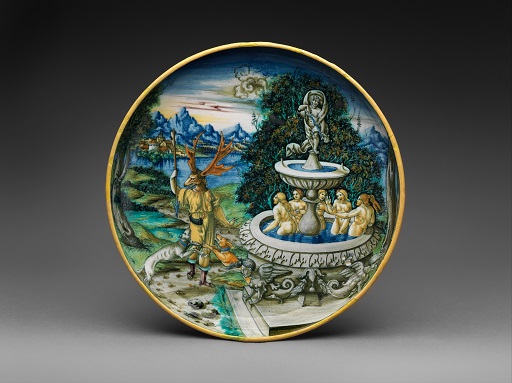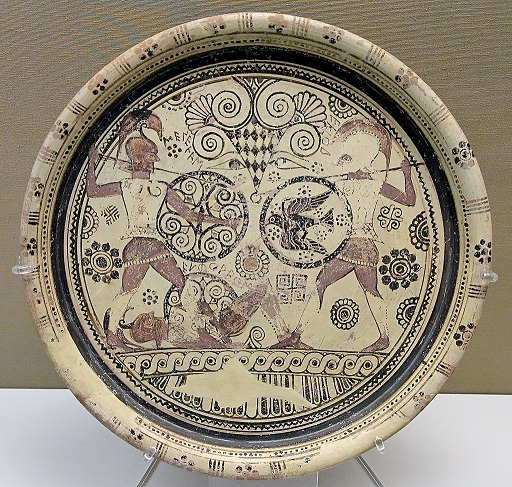8 Should we eat animals?
Reception is not something that only modern writers and artists engage in. It was also a frequent practice in the ancient world. In fact, towards the end of Ovid’s Metamorphoses, in Book 15, Ovid returns to the key idea in the story of Actaeon: the question of whether it is possible to draw a boundary between humans and animals. Within the body of the stag, Ovid invites us to recognise a human who has feelings and who is asking for our sympathy. In Book 15 we meet a character who takes this very seriously: Pythagoras. Here we see Ovid take the idea that humans can transform into animals one step further.
The Greek philosopher Pythagoras appears in Book 15 and argues that the fact that human souls can be found in animals is proof that animals should not be eaten. Pythagoras was not a character that Ovid invented – he was a real person, a philosopher who is still well known today for mathematical concepts like Pythagoras’ theorem. He was born on a Greek island called Samos in the sixth century BCE. He was also, famously in the ancient world, a committed vegetarian. Pythagoras believed in an idea known as metempsychosis – the idea that souls are immortal, and at the time of death pass from one living being into another. It was for this reason, he argued, that animals should not be eaten – because they might at one point have been human. In this final activity you will find out how closely Ovid’s mythical stories of transformation could reflect ancient philosophical beliefs. You will engage with the final one of Ovid’s big questions that you will be exploring in this course: should we eat animals?
Activity 17 An ancient vegetarian
The following extract is from Pythagoras’ attempt to make the case for vegetarianism in Book 15 of Ovid’s Metamorphoses in Stephanie McCarter’s translation. As you study this passage in this activity, you will be analysing the similarities between Pythagoras’ metempsychosis and Ovid’s metamorphosis. Read the passage through for the first time, and try to follow the logic of Pythagoras’ argument (even if you do not agree with it!). Then read it again and write down two examples of transformation that Pythagoras tells the reader about in this passage.
Souls do not die. Leaving their former post,
they come to new homes where they live and dwell.
I too recall that in the Trojan War
I was Euphorbus, son of Panthous,
whose heart the grievous spear of Menelaus
once pierced. I lately recognized a shield
my left hand bore in Argive Juno’s temple.
Everything changes, nothing dies. Our spirit
roams here and there, taking whatever limbs
it meets, moving from beasts to human bodies,
then back to beasts. It never perishes.
As soft wax is imprinted with new shapes
and does not keep the same form that it had,
yet it is the same, so is the soul the same,
while moving, as I teach, through various shapes.
Don’t let your belly’s lust break duty’s bonds.
Do not, I warn you, banish kindred souls
with evil slaughter, nor let blood feed blood.
Discussion
In this passage, Pythagoras is using the idea that the soul moves into a different body after death to make the case that humans should not eat animals. He gives the example of the soul ‘moving from beasts to human bodies’ and ‘then back to beasts’. Then he gives another example of transformation in lines 173–177, when he explains that his soul remembers being the soul of a different person, Euphorbus.
Transformation is key to the argument Pythagoras makes, which is that animals should not be eaten because they might contain human souls. Now that you have analysed the theme of transformation in this passage, you can think a little bit more deeply about how this relates to other stories about transformation that you have met in this unit. Read the passage through one more time. What similarities do you see between the kind of transformation that Pythagoras warns his readers of here, and the kind that you have read about in the story of Actaeon being transformed into a stag? Write a few sentences on the similarities between these two stories.
Discussion
Pythagoras implies that animals might have human souls in this extract. In the Actaeon story, we do not see this expressed in exactly the same way, but the idea is there. In his final moments the reader is told that Actaeon tried to speak as if he were still human – as if he had a human voice inside of his stag form. This is similar to Pythagoras’ argument that animals might contain a human soul on the inside of their animal bodies because of metempsychosis.

Where metempsychosis and metamorphosis overlap is the idea that the human is not a stable category. Both of these stories advise readers to be cautious in how they treat animals because the distinction between humans and animals is not as clear as it might seem. Comparing metempsychosis and metamorphosis in this way makes it possible to understand that the tales of transformation in Ovid’s poem were not just stories told for entertainment. They had deeper meanings, and help us to gain an insight into how people in the ancient world thought about big ideas and questions. In this case, they help us to understand how ancient answers to the question ‘what makes a human, human?’ might be different to the many ways that question could be answered today. Myths are not direct evidence for real life, of course. Actaeon was a mythical character, not a real person and many of the events that take place in Ovid’s Metamorphoses are fantastical and beyond belief. But these stories are engaged with big ideas and questions that tell us something about how Ovid’s readers made sense of the world around them.
Comparing metempsychosis and metamorphosis in this way helps me to understand that the tales of transformation in Ovid’s poem were not just stories told for entertainment. They have deeper meanings, and help us to gain an insight into how people in the ancient world thought about big ideas and questions. In this case, they help us to understand how ancient answers to big questions like ‘what makes a human, human?’ might be different to the many ways those questions could be answered today. Myths are not direct evidence for real life, of course. Actaeon was a mythical character, not a real person and many of the events that take place in Ovid’s Metamorphoses are fantastical and beyond belief. But these stories are engaged with big ideas and questions that tell us something about how Ovid’s readers made sense of the world around them.



